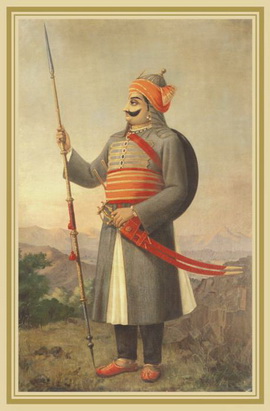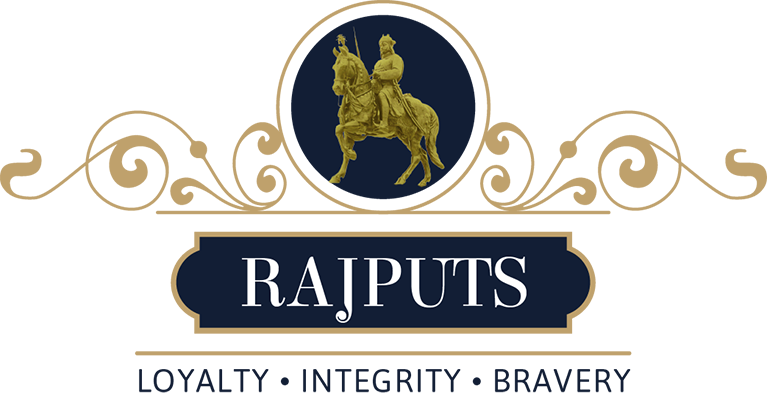Maharana Pratap or Pratap Singh (May 9, 1540 – January 19, 1597) was a Hindu Rajput ruler of Mewar, a region in north-western India in the present day state of Rajasthan. He belonged to the Sisodiya sept of Rajputs. In popular Indian culture, Pratap is considered to exemplify the qualities like bravery and chivalry to which Rajputs aspire, especially in context of his opposition to the Mughal emperor Akbar. The struggle between Rajput confederacy led by Pratap Singh, and the Mughal Empire under Akbar, has often been characterised as a struggle between Hindus and the invading Muslims.
History

|
|
| Reign: | 1568–1597 |
|---|---|
| Born: | May 9, 1540 |
| Birthplace: | Kumbhalgarh Fort, Rajasthan, India |
| Died: | January 19, 1597 (age 57) |
| Predecessor: | Udai Singh II |
| Successor: | Amar Singh I |
| Issue: | Amar Singh, Bhagwan Das (17 sons) |
| Royal House: | Sisodia |
| Father: | Udai Singh II |
| Mother: | Maharani Jaivantabai |
In 1568, during the reign of Udai Singh II, Chittor was conquered by the Mughal Emperor Akbar after the third Jauhar at Chittor. However, Udai Singh and the royal family of Mewar escaped before the capture of the fort and moved to the foothills of the Aravalli Range where Udai Singh founded the city of Udaipur in 1559. Rana Udai Singh had wished Jagmal, his son, from her favorite - the Bhatiyani queen to succeed him. But after his death the senior nobles wanted Pratap, the eldest son, to be their king as was customary. During the coronation ceremony, Jagmal was physically moved out of the palace by the Chundawat Chief and Tomar chief Ramshah and prevailed upon Pratap, who was crowned as the next Rana of Mewar. Folklore has it that Pratap did not want to go against the wishes of his father but Rajput nobles convinced him that Jagmal was not fit to rule in the troubled times of the day; but it is quite possible that what occurred was a bitterly contested struggle for succession: something characteristic of most South Asian kingdoms of the age.
Though the chief reasons for resentment between Pratap Singh and Akbar is unclear, it is now largely agreed that it had to do with disagreements over the status of Mewar within the Mughal Empire, were it to at all accept Mughal suzerainty. The tensions were further characterised by the fact that Babur and Rana Sanga, grandfathers to Akbar and Pratap respectively, had earlier bitterly contested the control over the Gangetic plains and the Doab. It is evident that there had been some measures of reconciliation, such as acceptance of ambassadors and representatives between the two courts. However, none of these could ever be taken to any logical end.
Conflict
Chittorgarh (Chittor fort), Pratap's ancestral home, was under Mughal occupation. Living a life on the run, the dream of reconquering Chittor (and thus reclaiming the glory of Mewar) was greatly cherished by Pratap, and his future efforts were bent towards this goal. In essence Pratap remained king of the whole of Rajputana (now Rajasthan) and the lands surrounding it except Chittor.
Nearly all of Pratap's fellow Rajput chiefs had meanwhile entered into the vassalage of the Mughals. Even Pratap's own brothers, Shakti Singh and Sagar Singh, served Akbar. Indeed, many Rajput chiefs, such as Raja Man Singh of Amber (later known as Maharaja of Jaipur) served as army commanders in Akbar's armies and as members of his council. Akbar sent a total of six diplomatic missions to Pratap, seeking to negotiate the same sort of peaceful alliance that he had concluded with the other Rajput chiefs. This is clearly evidential of the ends sought by each of the two rulers: for Akbar, having an independent or semi independent kingdom, within his otherwise consolidated empire was politically unsound and militarily dangerous; for Pratap Singh, on the other hand, to accept vassalage with little in return was a political suicide, and a steep fall for Mewar in the region's power structure.
Battle of Haldighati
On June 21, 1576 (June 18 by other calculations), the two armies met at Haldighati, near the town of Gogunda in present-day Rajasthan. While accounts vary as to the exact strength of the two armies, all sources concur that the Mughal forces outnumbered Pratap's men.
However, the numerical superiority of the Mughal army and their artillery began to tell. Seeing that the battle was favouring Akbar and with the huge amount of death of soldiers on both sides, Pratap's generals prevailed upon him to flee the field so as to be able to fight another day. Myths indicate that to facilitate Pratap's escape, one of his lieutenants, a member of the Jhala clan, donned Pratap's distinctive garments and took his place in the battlefield. He was soon killed. Meanwhile, riding his trusty steed Chetak, Pratap was able to successfully evade captivity and escape to the hills. However, Chetak was critically wounded on his left thigh by a mardana (Elephant Trunk Sword), with spear of weight 263 kg. while Pratap had attempted to nail down the Mughal Emperor Akbar. Chetak was bleeding heavily and he collapsed after jumping over a small brook a few kilometres away from the battle field.
Aftermath
Pratap retreated into the hilly wilderness of the Aravallis and continued his struggle. His one attempt at open confrontation having thus failed, Pratap resumed the tactics of guerrilla warfare. Using the hills as his base, Pratap continued small raids and skirmishes against the outlying check-posts, fortresses and encampments of his adversaries; some of whom included the Hindu vassals appointed by the Mughals in the wake of Pratap Singh's defeat.
During Pratap's exile, he received much assistance from Bhamashah, a trusted general and aide of Pratap, who along with his brother Tarachand looted Mughal territory of Malwa and offered this large booty to Pratap to carry on his fight against Mughal. Bhamashah was promoted to post of Prime Minister after this by Pratap.
With the large booty at his disposal, Pratap organized another attack and Battle of Dewar followed in which army of Mewar was victorious and Pratap was able to claim back much of the lost territories of Mewar, except Chittor.
Final days
Maharana Pratap died of injuries sustained in a hunting accident. He died at Chavand, which served as his capital, on 29 January 1597, aged fifty-seven. A chhatri, commemorating Pratap Singh's funeral, exists in Chavand and is an important tourist attraction today. It is said that as he lay dying, Pratap made his son and successor, Amar Singh, swear to maintain eternal conflict against the Mughals. Amar Singh fought 17 wars with the Mughals. After Mewar was depleted financially and in man-power he conditionally accepted them as rulers. The treaty between Amar Singh and Mughal King Jahangir had some obligations that fort of Chittor would not be repaired and Mewar would have to keep a contingent of 1000 horse in the Mughal service. Besides Amar Singh would not have to be present at any of the Mughal Darbars.
Back to list of Famous Rajput Personalities
Most of the information above is courtesy of Wikipedia.
For corrections, additions or comments, please submit a request through contact page.
